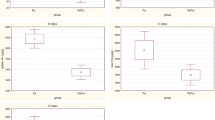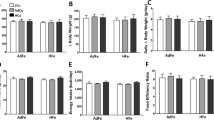Abstract
Previous work has shown that a low dietary intake of zinc for a short duration significantly lowers the lymphatic absorption of α-tocopherol (αTP) in adult male rats. The present study investigated whether the nutritional status of zinc is critical in maintaining the tissue levels of the vitamin. One group of rats was fed an AIN-93G diet containing 3 mg zinc/kg (low zinc, LZ) and the other was fed the same diet but containing 30 mg zinc/kg (adequate zinc, AZ). Food intakes between groups were matched by feeding two meals per day. At 6 wk, the body weights (356±8 g) of LZ rats reached 98% those (362±10 g) of AZ rats. Feeding of the LZ diet for 6 wk significantly lowered the concentrations of both αTP and zinc in the liver, kidney, heart, testis, and brain. No consistent relationships between αTP and zinc concentrations were observed in other tissues such as spleen, lung, gastrocnemius muscle, and retroperitoneal fat tissues. The concentrations of αTP in the liver, testis, brain, spleen, heart, and kidney were significantly correlated with the tissue concentrations of zinc. The LZ diet slightly but significantly increased the total lipid contents (mg/g) of liver, kidney, heart, and spleen. However, the tissue levels of phospholipid (µmol/100 mg lipid) in the heart, lung, testis, and spleen were decreased significantly in LZ rats. These findings indicate that low zinc intake results in a pronounced decrease in the animal’s αTP status under the conditions of matched food intakes, body weights, and feeding patterns. The lower tissue levels of αTP may explain in part the compromised antioxidant defense system and increased susceptibility to oxidative damage observed in zinc deficiency.
Similar content being viewed by others
References
S. R. Powell, The antioxidant properties of zinc, J. Nutr. 130, 1447S-1454S (2000).
R. A. DiSilvestro and G. P. Carlson, Effects of mild zinc deficiency, plus or minus acute phase response, on CC14 hepatotoxicity, Free Radical Biol. Med. 16, 57–61 (1994).
P. L. Oteiza, K. L. Olin, C. G. Fraga, and C. L. Keen, Zinc deficiency causes oxidative damage to proteins, lipids and DNA in rat testes, J. Nutr. 125, 823–829 (1995).
H.-P. Roth and M. Kirchgessner, Influence of zinc deficiency on the osmotic fragility of erythrocyte membrane of force-fed rats, Trace Elements and Electrolytes 1, 46–50 (1994).
Z. Xu and T. M. Bray, Electron spin resonance spin trapping studies of the effects of dietary zinc deficiency on free radical production in vitro and in vivo under acute oxidative stress, J. Nutr. Biochem. 5, 490–494 (1994).
R. A. DiSilvestro and A. Bolstein-Fujii, Moderate zinc deficiency in rats enhances lipoprotein oxidation in vitro, Free Radical Biol. Med. 22, 739–742 (1997).
P. Faure, A. M. Roussel, M. J. Richard, T. Foulon, P. Groslambert, A. Hadjian, et al., Effect of an acute zinc depletion on rat lipoprotein distribution and peroxidation, Biol. Trace Element Res. 28, 135–146 (1991).
J. F. Sullivan, M. M. Jetton, H. K. J. Hahn, and R. E. Burch, Enhanced lipid peroxidation in liver microsomes of zinc-deficient rats, Am. J. Clin. Nutr. 33, 51–56 (1980).
G. M. Wilkins and D. S. Leake, The oxidation of low density lipoprotein by cells or iron is inhibited by zinc, FEBS Lett. 341, 259–262 (1994).
A. Kraus, H. P. Roth, and M. Kirchgessner, Supplementation with vitamin C, vitamin E or beta-carotene influences osmotic fragility and oxidative damage of erythrocytes of zinc deficient rats, J. Nutr. 127, 1290–1296 (1997).
J. Xia, J. D. Browning, and B. L. O’Dell, Decreased plasma thiol concentration is associated with increased osmotic fragility of erythrocytes in zinc-deficient rats, J. Nutr. 129, 814–819 (1999).
W. J. Bettger and B. L. O’Dell, Physiological roles of zinc in the plasma membrane of mammalian cells, J. Nutr. Biochem. 4, 194–207 (1993).
T. M. Bray and W. J. Bettger, The physiological role of zinc as an antioxidant, Free Radical Biol. Med. 8, 281–291 (1990).
M. J. Bunk, A. M. Dnistrian, M. K. Schwartz, and R. S. Rivlin, Dietary zinc deficiency decreases plasma concentrations of vitamin E, Proc. Soc. Exp. Biol. Med. 190, 379–384 (1989).
W. J. Bettger, P. G. Reeves, J. E. Savage, and B. L. O’Dell, Interaction of zinc and vitamin E in the chick, Proc. Soc. Exp. Biol. Med. 163, 432–436 (1980).
E.-S. Kim, S. K. Noh, and S. I. Koo, Marginal zinc deficiency lowers the lymphatic absorption of α-tocopherol in rats, J. Nutr. 128, 265–270 (1998).
P. G. Reeves, F. H. Nielsen, and G. C. Fahey, Jr., AIN-93 purified diets for laboratory rodents: final report of the American Institute of Nutrition Ad Hoc Writing Committee on the reformulation of the AIN-76A rodent diet, J. Nutr. 123, 1939–1951 (1993).
P. G. Reeves, AIN-93 purified diets for the study of trace element metabolism in rodents, in Trace Elements in Laboratory Rodents, R. R. Watson, ed., CRC, Boca Raton, FL, pp. 3–37 (1996).
B. J. Zaspel and A. S. Csallany, Determination of alpha-tocopherol in tissues and plasma by high-performance liquid chromatography, Anal. Biochem. 130, 146–150 (1983).
J. Folch, M. Lees, and G. H. Sloane-Stanley, A simple method for the isolation and purification of total lipids from animal tissues, J. Biol. Chem. 226, 497–509 (1957).
R. K. Raheja, C. Kaur, A. Singh, and I. S. Bhatia, New colorimetric method for the quantitative estimation of phospholipids without acid digestion, J. Lipid Res. 14, 695–697 (1973).
L. L. Rudel and M. D. Morris, Determination of cholesterol using o-phthalaldehyde, J. Lipid Res. 21, 364–366 (1973).
V. Riley, Adaptation of orbital bleeding technique to rapid serial blood studies, Proc. Soc. Exp. Biol. Med. 104, 751–754 (1960).
SAS Institute, Inc., SAS User’s Guide: Statistics, 5th ed., SAS Institute, Cary, NC, pp. 433–506 (1985).
S. M. Chen and T. K. Young, Effects of zinc deficiency on endogenous antioxidant enzymes and lipid peroxidation in glomerular cells of normal and five-sixths nephrectomized rats, Journal of the Formosan Medical Association 97, 750–756 (1998).
C. Coudray, V. Charlon, J. de Leiris, and A. Favier, Effect of zinc deficiency on lipid peroxidation status and infarct size in rat hearts, Int. J. Cardiol. 41, 109–113 (1993).
M. D. Noseworthy and T. M. Bray, Zinc deficiency exacerbates loss in blood-brain barrier integrity induced by hyperoxia measured by dynamic MRI, Proc. Soc. Exp. Biol. Med. 223, 175–182 (2000).
P. L. Oteiza, K. L. Olin, C. G. Fraga, and C. L. Keen, Oxidant defense systems in testes from zinc-deficient rats, Proc. Soc. Exp. Biol. Med. 213, 85–91 (1996).
M. Kirchgessner, J. Plank, and H. P. Roth, Effect of dietary zinc deficiency on vitamin A and alpha-tocopherol metabolism in the rat, Z. Ernahrungswisso 26, 1–6 (1987).
K. Eder and M. Kirchgessner, The effect of dietary fat on activities of lipogenic enzymes in liver and adipose tissue of zinc-adequate and zinc-deficient rats, J. Nutr. Biochem. 7, 190–195 (1996).
P. G. Reeves and B. L. O’Dell, The effect of zinc deficiency on glucose metabolism in meal fed rats, Br. J. Nutr. 49, 441–452 (1983).
H. J. Kayden and M. G. Traber, Absorption, lipoprotein transport, and regulation of plasma concentrations of vitamin E in humans, J. Lipid Res. 34, 343–358 (1993).
M. G. Traber, T. Olivecrona, and H. J. Kayden, Bovine milk lipoprotein lipase transfers tocopherol to human fibroblasts during triglyceride hydrolysis in vitro, J. Clin. Invest. 75, 1729–1734 (1985).
W. Sattler, S. Levak-Frank, H. Radner, G. M. Kostner, and R. Zechner, Musclespecific overexpression of lipoprotein lipase in transgenic mice results in increased α-tocopherol levels in skeletal muscle, Biochem. J. 318, 15–19 (1996).
S. I. Koo and C. C. Lee, Effect of marginal zinc deficiency on lipoprotein lipase activities in postheparin plasma, skeletal muscle and adipose tissues in the rat, Lipids 24, 132–136 (1989).
J. Ahn and S. I. Koo, Effects of zinc and essential fatty acid deficiencies on the lymphatic absorption of vitamin A and secretion of phospholipids, J. Nutr. Biochem. 6, 595–603 (1995).
J. Ahn and S. I. Koo, Intraduodenal phosphatidylcholine infusion restores the lymphatic absorption of vitamin A and oleic acid in zinc-deficient rats, J. Nutr. Biochem. 6, 604–612 (1995).
J. Ahn, I. Choi, and S. I. Koo, Effect of zinc deficiency on intestinal absorption, plasma clearance, and urinary excretion of 3H-vitamin A in rats, J. Trace Elem. Exp. Med. 7, 53–166 (1995).
S. K. Noh and S. I. Koo, Enteral lysophosphatidylcholine restores the lymphatic absorption of retinol and α-tocopherol in zinc deficient rats, FASEB J. 14, A511 (2000).
M. Lindahl and C. Tagesson, Zinc (Zn2+) binds to and stimulates the activity of group I but not group II phospholipase A2, Inflammation 20, 599–611 (1996).
P. Tso and M. Scobey, The role of phosphatidylcholine in the absorption and transport of dietary fat, in Fat Absorption, A. Kuksis, ed., CRC, Boca Raton, FL, Vol. 1, pp. 177–195 (1986).
Author information
Authors and Affiliations
Rights and permissions
About this article
Cite this article
Noh, S.K., Koo, S.I. Feeding of a low-zinc diet lowers the tissue concentrations of α-tocopherol in adult rats. Biol Trace Elem Res 81, 153–168 (2001). https://doi.org/10.1385/BTER:81:2:153
Received:
Revised:
Accepted:
Issue Date:
DOI: https://doi.org/10.1385/BTER:81:2:153




